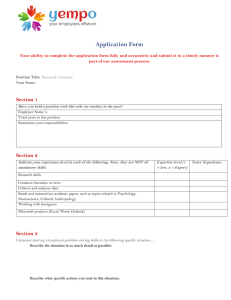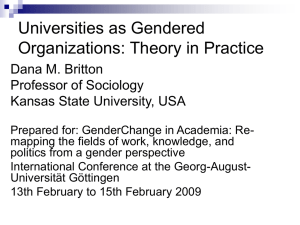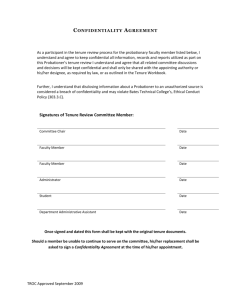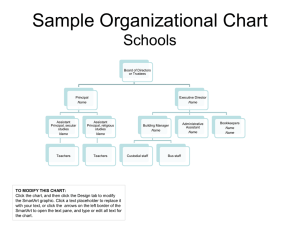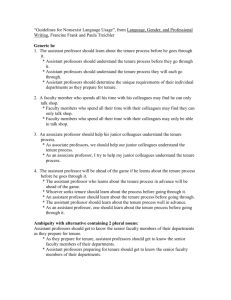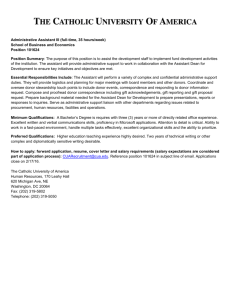The Bartol Report, 2006
advertisement
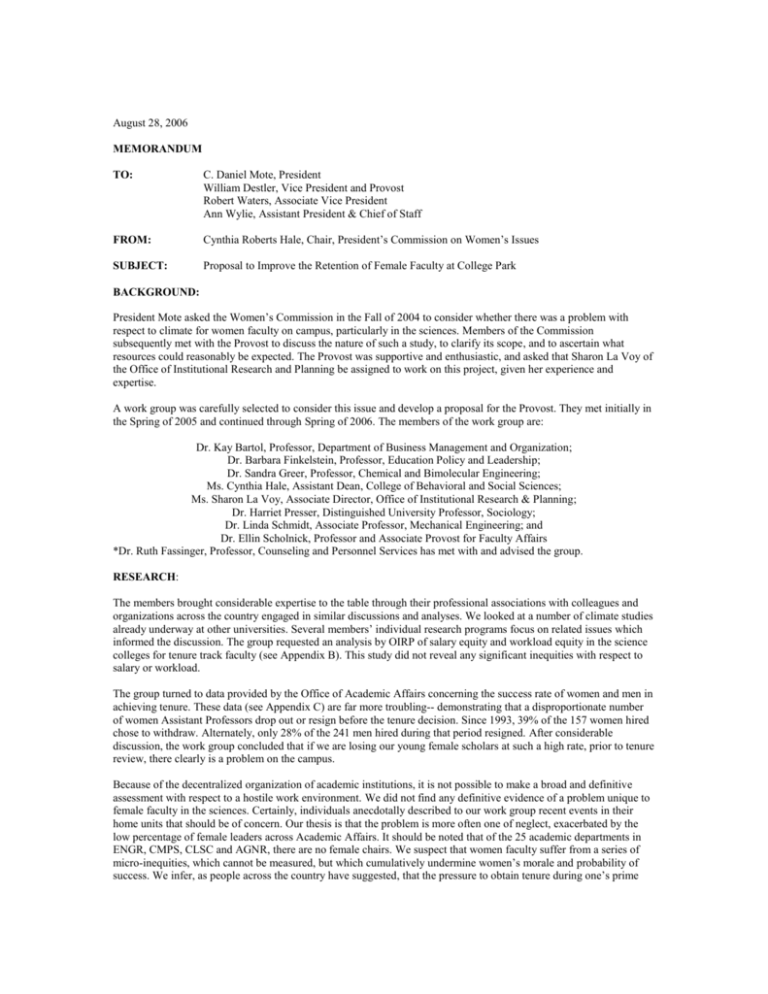
August 28, 2006 MEMORANDUM TO: C. Daniel Mote, President William Destler, Vice President and Provost Robert Waters, Associate Vice President Ann Wylie, Assistant President & Chief of Staff FROM: Cynthia Roberts Hale, Chair, President’s Commission on Women’s Issues SUBJECT: Proposal to Improve the Retention of Female Faculty at College Park BACKGROUND: President Mote asked the Women’s Commission in the Fall of 2004 to consider whether there was a problem with respect to climate for women faculty on campus, particularly in the sciences. Members of the Commission subsequently met with the Provost to discuss the nature of such a study, to clarify its scope, and to ascertain what resources could reasonably be expected. The Provost was supportive and enthusiastic, and asked that Sharon La Voy of the Office of Institutional Research and Planning be assigned to work on this project, given her experience and expertise. A work group was carefully selected to consider this issue and develop a proposal for the Provost. They met initially in the Spring of 2005 and continued through Spring of 2006. The members of the work group are: Dr. Kay Bartol, Professor, Department of Business Management and Organization; Dr. Barbara Finkelstein, Professor, Education Policy and Leadership; Dr. Sandra Greer, Professor, Chemical and Bimolecular Engineering; Ms. Cynthia Hale, Assistant Dean, College of Behavioral and Social Sciences; Ms. Sharon La Voy, Associate Director, Office of Institutional Research & Planning; Dr. Harriet Presser, Distinguished University Professor, Sociology; Dr. Linda Schmidt, Associate Professor, Mechanical Engineering; and Dr. Ellin Scholnick, Professor and Associate Provost for Faculty Affairs *Dr. Ruth Fassinger, Professor, Counseling and Personnel Services has met with and advised the group. RESEARCH: The members brought considerable expertise to the table through their professional associations with colleagues and organizations across the country engaged in similar discussions and analyses. We looked at a number of climate studies already underway at other universities. Several members’ individual research programs focus on related issues which informed the discussion. The group requested an analysis by OIRP of salary equity and workload equity in the science colleges for tenure track faculty (see Appendix B). This study did not reveal any significant inequities with respect to salary or workload. The group turned to data provided by the Office of Academic Affairs concerning the success rate of women and men in achieving tenure. These data (see Appendix C) are far more troubling-- demonstrating that a disproportionate number of women Assistant Professors drop out or resign before the tenure decision. Since 1993, 39% of the 157 women hired chose to withdraw. Alternately, only 28% of the 241 men hired during that period resigned. After considerable discussion, the work group concluded that if we are losing our young female scholars at such a high rate, prior to tenure review, there clearly is a problem on the campus. Because of the decentralized organization of academic institutions, it is not possible to make a broad and definitive assessment with respect to a hostile work environment. We did not find any definitive evidence of a problem unique to female faculty in the sciences. Certainly, individuals anecdotally described to our work group recent events in their home units that should be of concern. Our thesis is that the problem is more often one of neglect, exacerbated by the low percentage of female leaders across Academic Affairs. It should be noted that of the 25 academic departments in ENGR, CMPS, CLSC and AGNR, there are no female chairs. We suspect that women faculty suffer from a series of micro-inequities, which cannot be measured, but which cumulatively undermine women’s morale and probability of success. We infer, as people across the country have suggested, that the pressure to obtain tenure during one’s prime child-bearing years presents challenges which have not been acknowledged or satisfactorily addressed by academic institutions. RECOMMENDATIONS: Our own data, and the plethora of research available from institutions across the country on this issue, indicate that there is no need for additional assessments, surveys, or focus groups. We currently have a critical aspect of the problem clearly in view and believe we should take steps immediately to address this problem at College Park. We estimate that on average the campus invests a minimum of $525,000 in each new Assistant Professor during his/her first five years at the University (see appendix A for details). Each time a faculty member withdraws, it results in a significant loss of the institution’s investment. Improving our retention rate, even modestly, will produce a dramatic savings and a significant economy of scale. We recommend the implementation of a three-part intervention that will provide a) leadership and coaching, b) access to the best practices/state-of-the-art tenure strategies, and c) professional development opportunities. We suggest that a proposal to the NSF be prepared in response to an RFP for the ADVANCE initiative to seek funds to enhance our efforts to increase the retention of tenure track females. We recommend that an Advisory Group, representing the Women’s Commission, be established to work with those who staff this initiative and coordinate the drafting of the NSF proposal. This will assure continuity and adherence to our underlying principles. We recommend this group be charged with overseeing ongoing assessment of the effectiveness of our strategies, for the purpose of identifying those tactics that are successful and eliminating or modifying those which are not. INTERVENTION STRATEGY: A. Identify senior faculty who are distinguished scholars, and who will spend a sabbatical year working with female Assistant Professors in coaching them with respect to the tenure process. These individuals would, as appropriate, coordinate with Department Chairs and Deans, and would provide focused advice with respect to publication, grant writing, and managing teaching and service commitments. We envision these mentors as individuals of the stature of Drs. Harriet Presser, Eugenia Kalnay, Avis Cohen, Margaret Palmer, etc.; faculty of great achievement with a demonstrated interest in developing the next generation of female scholars and women in science. An alternate model would be to offer a course buy out to several such faculty who could comprise an elite team of senior level mentors, and who, while working together, would bring synergy to this nascent intervention model. B. Bring together the best practices and state of the art thinking from the myriad of programs and initiatives across the country, and create an online “Tenure Success Manual.” We propose to make this information available online to all Assistant Professors on the campus (access controlled by password). This would assure that all Assistant Professors, regardless of the climate in their home unit, would have access to the best advice and coaching material. A graduate assistant would be charged with this task, who would require some technical support. C. Hold “Professional Growth/Development Events” twice each semester for Assistant Professors, such as workshops to assist with grant writing, balancing work-life issues, advice on publishing in top journals, etc. These would be led by some of our most successful faculty and/or external experts, and would offer young faculty critical steps to success in achieving tenure. D. The mentor team, assisted by a graduate assistant, and members of the PCWI Advisory Board will work with others on the campus to craft a proposal to the National Science Foundation in response to their RFP for ADVANCE: Increasing Participation and Advancement of Women in Academic Science and Engineering Careers. The purpose of this proposal is to obtain external funding to support this initiative as we go forward. GOAL: Our goal is to improve the retention of female Assistant Professors by reducing the number who withdraw or resign before achieving tenure (we believe that faculty of color, who also have a high withdrawal rate, will benefit from this initiative, as well). As stated above, our own internal data indicate that between 1993 and 1999, 157 women were hired, and 62 resigned or withdrew before they came up for tenure review. This suggests a 39% drop out rate and a substantial loss of the funds invested in those scholars. We propose to define success at Maryland as decreasing our drop out rate from 39% for women to 29%, which is the current drop out rate for male faculty. This would involve annually retaining two more Assistant Professors, across the campus. Arguably, this modest improvement would preserve at least $1 million of our investment each year that we are successful. We propose that we work to reach the goal of reducing the drop out rate to 29% over five years. BUDGET: We believe that this program will minimally require the following resources: Sabbatical Pay for Stateswoman (50% Academic Year Salary for Professor) Fringes will be born by home unit/state pool $65,000 Graduate Assistant – 12 months Fringes will be born by state pool $18,000 Operating Costs (Four workshops at $2500 each/travel/publicity/supplies) $10,000* Start Up Costs $ 7,000* Total (computer/desk for student) $100,000 Budget Notes: *Perhaps the Deans of the 3 Science Colleges would contribute to the operating and start up costs. CONCLUSION: We believe that now is the time to proactively address the issue of why such a high percentage of our female Assistant Professors are dropping out before they are considered for tenure. In addition to undermining the presence of women scholars and leaders on our campus, it results in a significant loss of university resources. The recommendations we make in this proposal are modest and relatively simple to implement. A recent study on this issue at the Pennsylvania State University indicated that to date, mentoring and coaching appear to be some of the most effective ways to positively impact the success of women. An improvement of retaining just two more female faculty each year than we currently retain will allow us to leverage over $1 million of our investment. . Collins, L.C., Chrisler, J.C., & Quina, K. (1998). Career strategies for women in academe. Thousand Oaks, CA: Sage Publishing. Dooris, M.J. & Guidos, M. (2006). Tenure achievement rates at research universities. Chicago, IL: Association for Institutional Research. Mason, M. A., & Goulden, M. (November-December, 2002). “Do babies matter?” Academe, 88(6), 21-27 Mason, M. A., & Goulden , M. (November-December, 2004). “Do babies matter?” (part II) Academe, 90(6), 11-15. APPENDIX A. CAMPUS INVESTMENT: We estimate that the campus invests at least $525,000 over five years in each Assistant Professor appointment. We use five years because this is the average length of an appointment before resignation. We offer a conservative estimate of the investment, based on the following assumptions. In a number of disciplines the start up package greatly exceeds our estimate of $50,000: New Assistant Professor Hire: AY Salary Year 1 AY Salary Year 2 AY Salary Year 3 AY Salary Year 4 AY Salary Year 5 Total Salary $60,000 $62,000 $65,000 $68,000 $70,000 $325,000 Fringe Benefits $82,000 Total Salary & Wage $407,000 Recruitment & Moving $8,000 Equipment & Furniture $10,000 Travel fund ($2k/year) $10,000 Course Release (3 @ $5000) $15,000 Summer Support (3 @ 10%) $25,000 Individual packages estimate $50,000 (Grad assistants/spousal packages/lab set up/research equipment, etc.) Total 5 year investment for each assistant professor: $525,000.
